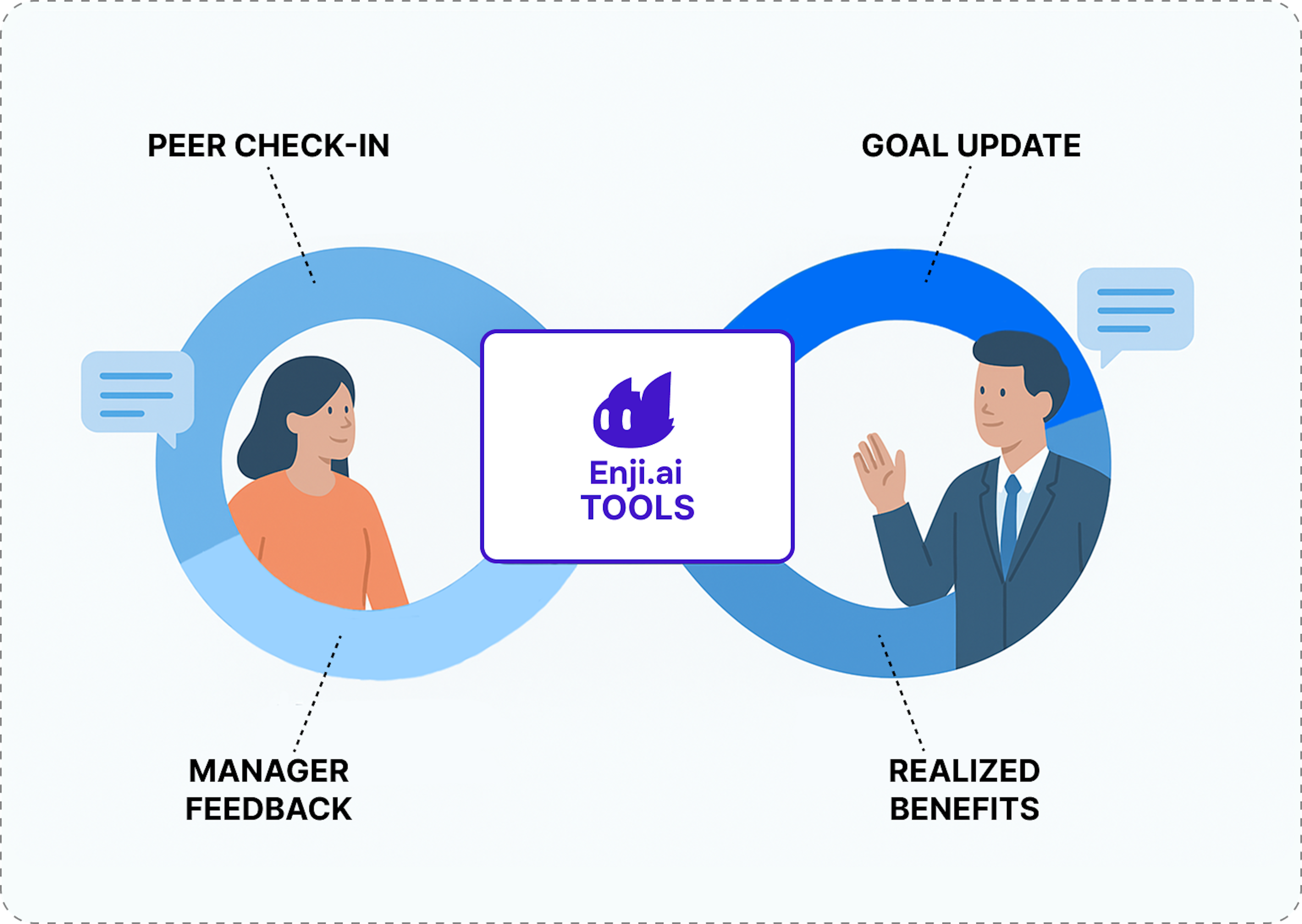Performance Management Glossary: Key Terms
Definition of CPM
What is continuous performance management?
Continuous performance management (CPM) is an ongoing approach to evaluating, supporting, and enhancing employee performance through regular feedback, consistent tracking of goal alignment, and real-time coaching.
Unlike traditional annual performance reviews, CPM replaces one-off evaluations with frequent check-ins, dynamic goal setting, and instant employee recognition. It emphasizes proactive improvement and alignment over retrospective assessment.
At its core, CPM shifts performance management from a static, backward-looking process to a real-time, adaptive framework that helps employees grow while keeping their work closely aligned with evolving business priorities.
Why is continuous performance management important?
Businesses are moving away from rigid review cycles because they struggle to adapt to today’s fast-paced, feedback-driven work culture. In many industries –and particularly in IT - rapid changes in technology, customer expectations, and market conditions make annual or semiannual reviews obsolete by the time they happen. Continuous performance management creates shorter feedback loops, aligns goals to shifting priorities, and helps teams respond to real-time data rather than outdated plans:
- Real-time alignment – Keeps individual objectives matched with shifting company priorities.
- Higher engagement – Frequent feedback fosters better communication and employee involvement.
- Faster skill development – Immediate coaching helps close skill and behavior gaps before they impact results.
- Better collaboration – Encourages open dialogue between managers and teams throughout projects.
- Improved flexibility – Adapts to rapid changes in project scope, market demands, or team structure.
- Data-driven decisions – Ongoing measurement produces current, actionable performance insights.
In practice, CPM enables employees to adjust their performance in real time rather than being judged months later, leading to continuous improvement and stronger business results.
How to implement continuous performance management?
Implementing CPM requires strategy, technology, and culture change. While highly rewarding, businesses must plan and apply all required operational guidelines, defining goals, establishing KPIs, and implementing suitable solutions:
- Define goals and success metrics
▫️ Establish clear, measurable objectives at both organizational and individual levels.
▫️ Align goals with business strategy to ensure every check-in moves the needle. - Train managers and employees
▫️ Managers need skills in giving constructive, timely feedback.
▫️ Employees must be prepared to receive and act on feedback regularly. - Adopt the right tools
▫️ Use platforms that support real-time goal tracking, feedback exchange, and performance analytics.
▫️ Ensure integration with existing workflow tools. - Embed in company culture
▫️ Make regular performance conversations a natural, expected part of work life.
▫️ Reinforce openness and trust to avoid perceptions of micromanagement. - Review and optimize
▫️ Use data to refine processes, ensuring that CPM remains relevant and effective.
Common challenges: Resistance to change, unclear expectations, lack of training, and insufficient technology integration often slow adoption. Overcoming them requires clear communication, patience, and leadership buy-in.
What does the future of continuous performance management look like?
The future of CPM will be shaped by AI-driven analytics, predictive insights, and deeper integration with workflow tools.
Emerging trends include:
- Personalized performance coaching via AI assistants that suggest real-time skill-building activities.
- Automated KPI tracking using integrated data from project management, sales, and HR systems.
- Continuous goal recalibration to reflect live business conditions.
- Well-being metrics are included in performance tracking to balance productivity and employee health.
- Hybrid-ready performance practices tailored for distributed and flexible work environments.
As companies embrace data transparency and agile goal management, CPM will evolve into a core driver of employee retention, innovation, and competitive advantage.
How can Enji be used in continuous performance management?
Enji's platform is purpose-built to support continuous improvement—making it an ideal tool to implement and sustain CPM effectively. Key Enji features for CPM include:
- Enlightening worklogs – Track planned vs. actual contributions for every team member, identifying performance trends in real time.
- Employee pulse – Monitor engagement, workload balance, and early burnout signals to maintain sustainable performance levels.
- Agile metrics dashboard – Visualize delivery KPIs like cycle time, estimation accuracy, and rejection rate to guide improvement conversations.
- Automated alerts – Receive instant notifications when performance indicators deviate from healthy ranges, enabling timely intervention.
- Retrospective-ready reports – Use concrete, up-to-date data in feedback sessions for a more constructive and fact-based dialogue.
- Pull request analytics – In development teams, evaluate review times, WIP limits, and throughput to spot both high and low performers constructively.
Example: If testing stages suddenly take twice as long, Enji's dashboards pinpoint this change, show how many tasks are affected, and alert project leads—so they can reassign testers or automate steps before delays cascade.
Key Takeaways
- Continuous performance management replaces annual reviews with frequent, forward-focused feedback loops.
- It is important because it drives higher engagement, faster skill development, and better alignment with business goals.
- Implementing CPM requires clear objectives, cultural buy-in, the right tools, and ongoing process optimization.
- The future of CPM is AI-enhanced, data-driven, and seamlessly embedded in daily workflows.
- Enji enables sustainable CPM through real-time performance monitoring, proactive alerts, employee well-being tracking, and metric-driven coaching.
Last updated in August 2025

